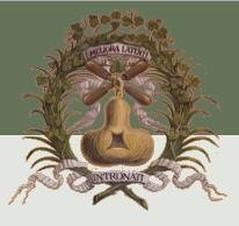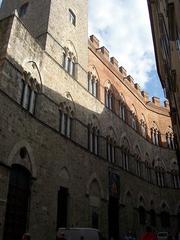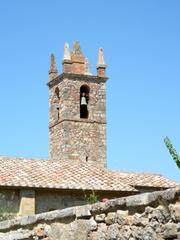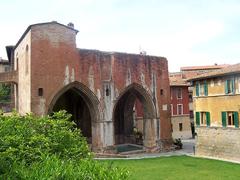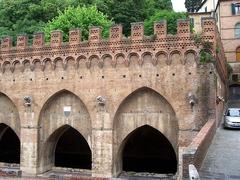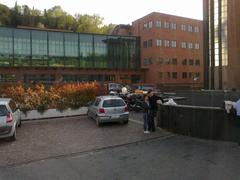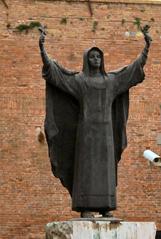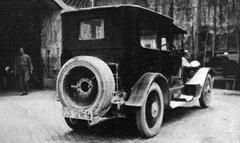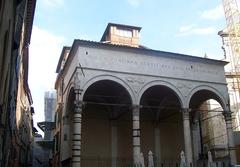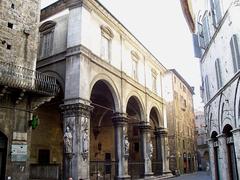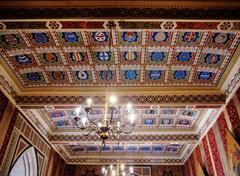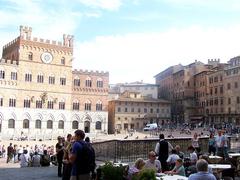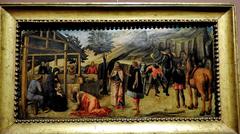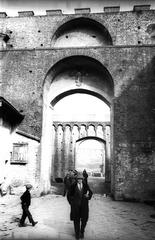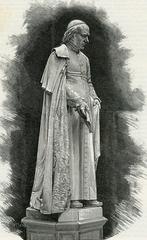San Donato a Ginestreto Visiting Hours, Tickets, and Siena Historical Sites Guide
Date: 14/06/2025
Introduction to San Donato a Ginestreto
San Donato a Ginestreto, located in the rolling hills near Siena in Tuscany, is an exceptional example of rural Italian heritage. The site comprises a historic parish church and its surrounding hamlet, offering travelers a journey through centuries of religious, cultural, and architectural evolution. Established as early as the 10th century and associated with prominent monastic orders—including the Vallombrosan Benedictines and Carmelites—San Donato a Ginestreto has long served as a religious and community landmark. Its architecture features Romanesque, Gothic, and Baroque elements, while the tranquil rural setting provides an authentic Tuscan experience away from the region’s tourist hotspots (Wikipedia; Old Town Explorer; Visit Siena Official).
The adjoining hamlet and estates, such as Fattoria San Donato, offer immersive activities—from exploring medieval architecture to tasting local wines and olive oils, and hiking the scenic countryside (Fattoria San Donato). This guide provides comprehensive information on the history, visiting logistics, local etiquette, and nearby attractions, equipping you for a memorable visit to one of Tuscany’s hidden gems.
Contents
- Historical Overview
- Origins and Early Development
- Architectural Evolution
- Cultural and Religious Significance
- Art, Heritage, and Community Life
- Visiting San Donato a Ginestreto
- Visiting Hours and Tickets
- Accessibility and Directions
- Best Times to Visit
- Accommodation and Local Cuisine
- Activities and Experiences
- Cultural Etiquette and Local Insights
- Practical Visitor Information
- Nearby Attractions
- Sustainable Tourism
- Frequently Asked Questions (FAQ)
- Conclusion
- Sources
Historical Overview
Origins and Early Development
San Donato a Ginestreto’s foundation dates to the early medieval period, serving as a spiritual hub in the Sienese countryside. The parish emerged as part of the Christianization of rural Tuscany, with documentary evidence of monastic life from the 12th century. In 1109, a presbyter named Pietro—later a Vallombrosan monk—received papal authorization to establish a monastery in line with the customs of the Abbey of San Michele in Passignano in Chianti (Wikipedia).
Originally dedicated to San Michele Arcangelo (Saint Michael the Archangel), the church later assumed the patronage of San Donato, reflecting shifts in local devotional practice. The site’s monastic heritage is still recalled in its nickname, “l’Abbadia.”
Architectural Evolution
San Donato a Ginestreto showcases Romanesque architecture—thick stone walls and rounded arches—augmented by later Gothic and Baroque features. The 17th-century Baroque transformation, led by the Carmelite Fathers, introduced ornate stucco, elaborate altarpieces, and dynamic liturgical spaces, aligning with Counter-Reformation aesthetics (Old Town Explorer).
Cultural and Religious Significance
The church has served as the focal point for community life, hosting baptisms, weddings, and the annual feast day of Saint Donatus. From its monastic roots to its role as a parish center, San Donato a Ginestreto reflects the evolving spiritual and social landscape of rural Siena.
Art, Heritage, and Community Life
San Donato a Ginestreto’s interior houses significant artworks, including frescoes and altarpieces influenced by the Sienese school of painting. Heraldic symbols, such as the Order of Saint Stephen’s red octagonal cross, highlight the church’s historical ties to dynastic and civic traditions. Restoration projects underscore its value within the UNESCO-listed Siena territory (Wikipedia; Old Town Explorer).
The church remains active in hosting religious services and festivals, contributing to the area’s cultural vibrancy and welcoming visitors seeking authentic experiences.
Visiting San Donato a Ginestreto
Visiting Hours and Tickets
- Church Hours: Typically open Tuesday to Sunday, 9:00 AM–5:00 PM (or 10:00 AM–5:00 PM in Siena’s historic center). Closed Mondays and major public holidays. Always verify seasonal schedules on the Visit Siena Official website or with local tourist offices.
- Tickets: Entry to the church is free; donations are welcomed for preservation. Some attractions in the hamlet (e.g., the medieval tower) may charge a fee (~€5 per adult), with discounts for children, seniors, and groups. Purchase tickets on-site or via the Fattoria San Donato website.
- Guided Tours: Available by advance booking through local providers or tourist offices, especially recommended during peak seasons for historical context and access to restricted areas.
Accessibility and Directions
- By Car: San Donato a Ginestreto is about 10 km south of Siena. Drive via the SR2 road; parking is available along rural roads or outside the hamlet.
- Public Transport: Limited; taxis or guided tours are suitable alternatives.
- On Foot: The church in Siena’s historic center (Piazza dell’Abbadia) is a 10-minute walk from Piazza del Campo.
- Accessibility: Ramps are installed at main entrances; some cobblestones and uneven surfaces may challenge visitors with limited mobility. Contact ahead for detailed information.
Best Times to Visit
- Spring (May–June) and Early Autumn (September–October): Pleasant weather, fewer crowds, and vibrant countryside.
- Feast Day of San Donatus (early August): Experience local processions and cultural events.
Accommodation and Local Cuisine
Where to Stay
- Fattoria San Donato: Historic farmhouse offering agriturismo lodgings, from rustic apartments to guest rooms surrounded by vineyards and olive groves (Fattoria San Donato).
- Nearby Towns: San Gimignano and Volterra feature a range of hotels, B&Bs, and boutique stays.
Dining
- Onsite: Fattoria San Donato serves farm-to-table meals, homemade pasta, estate wines, and breakfasts in the medieval tower.
- Nearby: San Gimignano offers acclaimed restaurants such as La Taverna di San Giuseppe. Advance reservations are advised during high season (The Travel Folk).
Activities and Experiences
- Historical Exploration: Discover the fortified villa, medieval tower, and Romanesque church. The hamlet’s layout is ideal for walks and photography.
- Wine and Olive Oil Tasting: Participate in guided tours and tastings at Fattoria San Donato, rooted in Etruscan winemaking traditions.
- Outdoor Recreation: Hiking, cycling, and horseback riding are popular, with trails connecting to neighboring villages and sites like the Castelvecchio ruins—a haven for birdwatchers (Fattoria San Donato).
Cultural Etiquette and Local Insights
- Greetings: Use “Buongiorno”/“Buonasera” and titles (Signor/Signora). A handshake is standard; cheek kisses are reserved for friends (Iriemade).
- Dining: Wait for everyone to be served, bring a small gift when invited to a home, use utensils for pasta and pizza, finish your plate, and avoid contentious topics (Fluent Fast Italian).
- Dress: Smart-casual attire is expected; cover shoulders and knees when visiting churches.
- Church Visits: Speak quietly, avoid flash photography, and remove hats. Check for local restrictions during services (Fluent Fast Italian).
- Local Routine: Shops close for siesta (1–4 pm). Greet vendors at markets and handle produce gently (The Tuscan Mom).
- Sustainability: Use refillable bottles, minimize waste, and respect the landscape (Visit Siena Official).
Practical Visitor Information
- Contact: Loc. San Donato, 6, 53037 San Gimignano (Siena), Italy | +39 0577 941616 | [email protected]
- Language: Italian is primary; English is commonly spoken at tourist venues.
- Currency: Euro (€); cards accepted, but carry some cash.
- Connectivity: Good mobile coverage; Wi-Fi at most accommodations.
Nearby Attractions
- San Gimignano: Medieval towers and UNESCO-listed center (The Crazy Tourist).
- Volterra: Etruscan ruins and alabaster crafts.
- Siena: Cathedral, Piazza del Campo, Palio horse race (History Tools).
- Chianti: Scenic wine roads and tastings (Chianti.com).
Sustainable Tourism
San Donato a Ginestreto and its local businesses, such as Fattoria San Donato, promote organic farming and heritage preservation. Support these efforts by minimizing waste, respecting the environment, and choosing sustainable travel options.
Frequently Asked Questions (FAQ)
Q: What are the visiting hours for San Donato a Ginestreto’s main sites?
A: Generally 9:00 AM–6:00 PM (April–October), 10:00 AM–4:00 PM (November–March). Closed Mondays. Verify with the official website.
Q: Is there an entrance fee?
A: Entry to the hamlet is free; some sites may charge a small fee (~€5). Discounts available for children, seniors, and groups.
Q: Are guided tours available?
A: Yes, bookable via Fattoria San Donato or local tourist offices.
Q: Is the site accessible for visitors with mobility issues?
A: Some areas are accessible, but cobblestones and steps exist. Contact accommodations or local offices for details.
Q: What is the best time of year to visit?
A: Late spring and early autumn for pleasant weather and fewer crowds.
Q: Can I take photos inside the church?
A: Photography is generally allowed without flash; observe posted restrictions.
Conclusion
San Donato a Ginestreto is a testament to Tuscany’s rich religious, artistic, and rural heritage. Its accessible hours, free admission, and immersive experiences make it an ideal destination for history enthusiasts, cultural travelers, and anyone seeking the charm of the Tuscan countryside. Enhance your visit by exploring nearby cities, respecting local customs, and engaging in sustainable travel. For up-to-date information, visit the Fattoria San Donato website and Visit Siena Official.
Download the Audiala app for personalized audio tours, and follow us on social media for the latest updates and travel inspiration.
Sources
- Wikipedia: Chiesa di San Donato (Siena)
- Old Town Explorer: Siena Architecture
- Visit Siena Official: Siena Tourism Official Website
- Fattoria San Donato: About Us
- The Thinking Traveller: Siena Tuscany Guide
- The Crazy Tourist: Best Things to Do in Siena
- History Tools: Historic Centre of Siena
- Iriemade: Cultural Etiquette in Italy
- Fluent Fast Italian: Italian Cultural Etiquette
